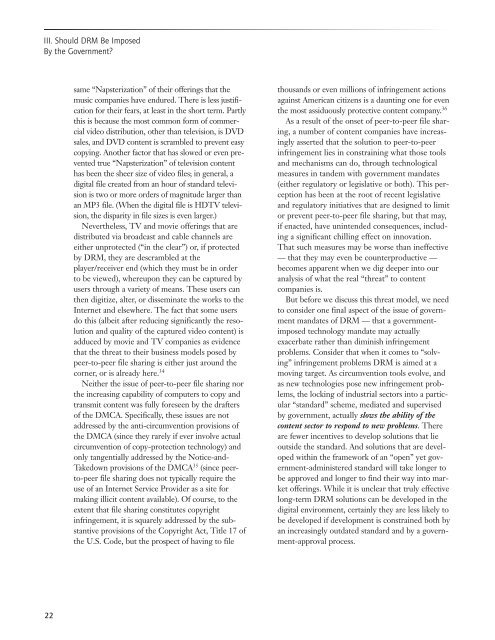What Every Citizen Should Know About DRM, aka - Public Knowledge
What Every Citizen Should Know About DRM, aka - Public Knowledge
What Every Citizen Should Know About DRM, aka - Public Knowledge
You also want an ePaper? Increase the reach of your titles
YUMPU automatically turns print PDFs into web optimized ePapers that Google loves.
III. <strong>Should</strong> <strong>DRM</strong> Be ImposedBy the Government?same “Napsterization” of their offerings that themusic companies have endured. There is less justificationfor their fears, at least in the short term. Partlythis is because the most common form of commercialvideo distribution, other than television, is DVDsales, and DVD content is scrambled to prevent easycopying. Another factor that has slowed or even preventedtrue “Napsterization” of television contenthas been the sheer size of video files; in general, adigital file created from an hour of standard televisionis two or more orders of magnitude larger thanan MP3 file. (When the digital file is HDTV television,the disparity in file sizes is even larger.)Nevertheless, TV and movie offerings that aredistributed via broadcast and cable channels areeither unprotected (“in the clear”) or, if protectedby <strong>DRM</strong>, they are descrambled at theplayer/receiver end (which they must be in orderto be viewed), whereupon they can be captured byusers through a variety of means. These users canthen digitize, alter, or disseminate the works to theInternet and elsewhere. The fact that some usersdo this (albeit after reducing significantly the resolutionand quality of the captured video content) isadduced by movie and TV companies as evidencethat the threat to their business models posed bypeer-to-peer file sharing is either just around thecorner, or is already here. 34Neither the issue of peer-to-peer file sharing northe increasing capability of computers to copy andtransmit content was fully foreseen by the draftersof the DMCA. Specifically, these issues are notaddressed by the anti-circumvention provisions ofthe DMCA (since they rarely if ever involve actualcircumvention of copy-protection technology) andonly tangentially addressed by the Notice-and-Takedown provisions of the DMCA 35 (since peerto-peerfile sharing does not typically require theuse of an Internet Service Provider as a site formaking illicit content available). Of course, to theextent that file sharing constitutes copyrightinfringement, it is squarely addressed by the substantiveprovisions of the Copyright Act, Title 17 ofthe U.S. Code, but the prospect of having to filethousands or even millions of infringement actionsagainst American citizens is a daunting one for eventhe most assiduously protective content company. 36As a result of the onset of peer-to-peer file sharing,a number of content companies have increasinglyasserted that the solution to peer-to-peerinfringement lies in constraining what those toolsand mechanisms can do, through technologicalmeasures in tandem with government mandates(either regulatory or legislative or both). This perceptionhas been at the root of recent legislativeand regulatory initiatives that are designed to limitor prevent peer-to-peer file sharing, but that may,if enacted, have unintended consequences, includinga significant chilling effect on innovation.That such measures may be worse than ineffective— that they may even be counterproductive —becomes apparent when we dig deeper into ouranalysis of what the real “threat” to contentcompanies is.But before we discuss this threat model, we needto consider one final aspect of the issue of governmentmandates of <strong>DRM</strong> — that a governmentimposedtechnology mandate may actuallyexacerbate rather than diminish infringementproblems. Consider that when it comes to “solving”infringement problems <strong>DRM</strong> is aimed at amoving target. As circumvention tools evolve, andas new technologies pose new infringement problems,the locking of industrial sectors into a particular“standard” scheme, mediated and supervisedby government, actually slows the ability of thecontent sector to respond to new problems. Thereare fewer incentives to develop solutions that lieoutside the standard. And solutions that are developedwithin the framework of an “open” yet government-administeredstandard will take longer tobe approved and longer to find their way into marketofferings. While it is unclear that truly effectivelong-term <strong>DRM</strong> solutions can be developed in thedigital environment, certainly they are less likely tobe developed if development is constrained both byan increasingly outdated standard and by a government-approvalprocess.22





